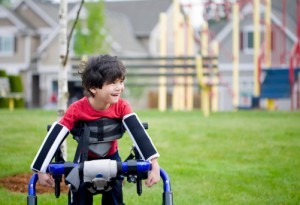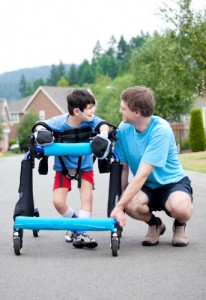 Cerebral palsy is a broad term for a condition that affects an individual’s posture, muscle tone, balance and movement. Cerebral palsy can result during embryonic development or it can be the unfortunate result of a traumatic birth injury. Often, cerebral palsy results from inadequate blood or oxygen. Other possible causes can be seen here. There are five different types of cerebral palsy, each explained below.
Cerebral palsy is a broad term for a condition that affects an individual’s posture, muscle tone, balance and movement. Cerebral palsy can result during embryonic development or it can be the unfortunate result of a traumatic birth injury. Often, cerebral palsy results from inadequate blood or oxygen. Other possible causes can be seen here. There are five different types of cerebral palsy, each explained below.
Spastic Cerebral Palsy
When children are diagnosed with cerebral palsy, most children will be diagnosed with spastic cerebral palsy. In fact, spastic cerebral palsy affects between 80 and 90 percent of cerebral palsy sufferers. This type can affect one side of the body, it can affect two limbs, or it can affect all four limbs. When two limbs are affected, this is known as spastic diplegia. When four limbs are affected, this is known as spastic quadriplegia.
Spastic cerebral palsy causes muscle tightness and can sometimes cause an individual to have difficulty communicating. The symptoms of this type of cerebral palsy are treated with physical therapy, stretching, exercises, and sometimes, Botox. It is important to note that this does not affect an individual’s intelligence.
Athetoid Cerebral Palsy
Athetoid cerebral palsy affects about 20 percent of cerebral palsy sufferers and the symptoms are slightly different from the previously mentioned type of cerebral palsy. Athetoid cerebral palsy can cause slow, involuntary muscle movements, especially of the torso and of the extremities. Sometimes this type of cerebral palsy also affects face and tongue muscles, in which case drug and speech therapy is required. Muscle tone with this type of cerebral palsy is mixed; it can either be too high or too low.
Hypotonic Cerebral Palsy
Hypotonic cerebral palsy results in very uncontrollable, floppy arms and legs. It also tends to affect the individual’s posture, so they will often slouch or lie down. Trouble controlling and holding the head in a neutral position is also difficult for individuals with this type of cerebral palsy. Additionally, fatigue is a very common symptom of hypotonic cerebral palsy.
Ataxic Cerebral Palsy
Ataxic cerebral palsy is the least common type of cerebral palsy, and less than 5 percent of individuals with cerebral palsy will have the ataxic variety. This type of cerebral palsy affects how well an individual can balance and coordinate their muscles. Individuals will have poorly defined muscle tone and will have difficulty moving.
Mixed Cerebral Palsy
It is possible for individuals to be affected by a combination of different types of cerebral palsy, which is known as mixed cerebral palsy. When this presents, it is most common for the spastic and athetoid types to be mixed together, although mixing of any of the types of cerebral palsy is possible.
Sometimes cerebral palsy cannot be prevented, as it can occur during embryonic development. However, sometimes cerebral palsy is the result of a traumatic birth injury. Again, this can be unpreventable or it can be result of medical negligence.
If you or someone you know has a child with cerebral palsy, and you believe it could be the result of medical negligence, consider seeking the professional help of an experienced birth injury lawyer. Salvi, Schostok & Pritchard, P.C. is a law firm comprised of cerebral palsy injury and birth injury lawyers located in Illinois. For more information about birth injuries and cerebral palsy, visit the website at www.CerebralPalsyInjuries.com.

